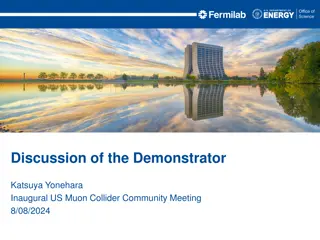Current Status of Front End Systems in Particle Collider Research
David Neuffer presented the current status of front end systems for particle colliders on December 4, 2014. The presentation covered various aspects like baseline examples, beam characteristics, drift mechanisms, cooling methods, and simulation results. It provided insights into the operational mechanisms of the system including bunching, rotating, and cooling of beams to achieve desired particle energies and collision parameters. The comparison of system configurations with and without chicane indicated the impact on beam characteristics and efficiency in collider operations.
Download Presentation

Please find below an Image/Link to download the presentation.
The content on the website is provided AS IS for your information and personal use only. It may not be sold, licensed, or shared on other websites without obtaining consent from the author.If you encounter any issues during the download, it is possible that the publisher has removed the file from their server.
You are allowed to download the files provided on this website for personal or commercial use, subject to the condition that they are used lawfully. All files are the property of their respective owners.
The content on the website is provided AS IS for your information and personal use only. It may not be sold, licensed, or shared on other websites without obtaining consent from the author.
E N D
Presentation Transcript
Front End present status David Neuffer December 4, 2014 1
Outline Previous Versions 201.25 MHz baseline examples 24/8GeV initial beam Front End for Muon Collider/ Neutrino Factory Baseline for MAP 8 GeV proton beam on Hg target 325 MHz With Chicane/Absorber Current status New targetry 6.75 GeV on C target Possible changes 2
IDS Baseline Buncher and -E Rotator Drift ( ) Adiabatically bunch beam first (weak 320 to 232 MHz rf) -E rotate bunches align bunches to ~equal energies 232 to 202 MHz, 12MV/m Cool beam 201.25MHz Captures and Cools both + and - p FE Targ et Drift Buncher Rotator Cooler Solenoid 18.9 m ~60.7 m ~80 m ~33m 42 m 3
325MHz System Collider p FE Target Solenoid Drift Buncher Rotator Cooler 14.75m ~21.0 m ~24.0 m ~80 m ~42 m Drift 20T 2T Buncher Po=250MeV/c PN=154 MeV/c; N=10 Vrf : 0 15 MV/m (2/3 occupied) fRF : 490 365MHz Rotator Vrf : 20MV/m (2/3 occupied) fRF : 364 326MHz N=12.045 P0, PN 245 MeV/c Cooler 245 MeV/c 325 MHz 25 MV/m 2 1.5 cm LiH absorbers /0.75m 4
Simulation Results Simulation obtains ~0.125 /p within acceptances with ~60m Cooler 325 MHz less power shorter than baseline NF But uses higher gradient higher frequency rf smaller cavities shorter than baseline NF more bunches in bunch train N :0.15<P<0.35 GeV/c N: T<0.03; AL<0.2 N: T<0.015; AL<0.2 Useful cooling 5
325 Collider w 325 Collider w Chicane/Absorber Chicane/Absorber Chicane + Absorber SREGION ! bentsol 6.5 1 1e-2 1 0. 1.0 BSOL 1 2.0 0.0 1 0.283 0.0 0.058181 0.0 0.0 0.0 0. 0. 0. 0. 0. VAC NONE 0. 0. 0. 0. 0. 0. 0. 0. 0. 0. Add 30 m drift after chicane *6.5m +21.67 ,-21.67 Add chicane + absorber particle 1-283 MeV/c particle 2-194 MeV/c absorber at 54m 10cm Be particle 1-250 MeV/c particle 2-154 MeV/c Bunch (N=12) 0 15 MV/m :496 365 MHz Rotate (N=12.045 ) 20MV/m : 365 326.5 MHz Cool -325MHz -25 MV/m pref=245 MeV/c
Compare without/with chicane 0m (production target) -30m -50m 1600 GeV/c 0m 66m (after chicane/absorber) 0 GeV/c 1600 GeV/c 88m (after drift) 57m 0 GeV/c 109m (after buncher) 79m 102m 50m 132m (after rotator) -30m 21 bunches for Collider 152m 190m (after cooling) 7
ICOOL results 325 muon collider with chicane absorber with added drift between chicane and absorber ~30m ~0.12 /p ~0.105 /p smaller emittance beams scraped to better fit All + (0.15<p <0.35) + (A <0.03, AL <0.2) 8
ICOOL results Change to shorter taper 15m 6m (Hisham) slight improvement in throughput (~5%) We were using Hishams more recent distributions (May 2014) Gains ~5 10% Total is now ~0.115 /p (in baseline ICOOL simulation units) 9
New Proton Driver parameters 6.75 GeV p, C target 20 2T short taper ~5m (previously 15) X. Ding produced particles at z=2m using Mars short initial beam Redo ICOOL data sets to match initial beam ref particles redefined in for003.dat and for001.dat p FE Target Drift Solenoid Buncher Rotator Cooler 10 5m ~21.0 m ~24.0 m ~80 m ~52 m
Use old FE with new initial beam New beam has too large initial size and divergence initial transverse emittance >2X larger 0.0027 0.0067 m-GeV/c ~half of initial beam lost in <6m new beam at z=3m 0.4 -0.4 old beam at z=3m -0.4 0.4 11
First simulations results ~60% of initial particles are lost in first 6m previous front end lost ~20% z=2m 20000 Beam starts out very large previous much smaller in front end simulations /p reduced by factor ~ 2 ~0.0545 +/p ~0.042 -/p - less than + Not fully reoptimized for new initial beam z=8m 8386 z=77m 7500 z=137m 5892 12
6.75 GeV p/ C target First Look Much worse than previous 8 GeV p / Hg target 6.75 (~25% less), Hg C but initial beam has very large phase space Causes for early losses ??? Long C target not a good match to short taper ? target should be within lens center Beam dump after target blows up beam ?? Bugs, errors? Changes in Mars production code ?? normalization error ?? initialization errors starts from z=2m rather than z=0 After initial factor of 2 loss, very similar to old front end case not yet reoptimized To investigate/debug/reoptimize .. 13
Other topics to explore Replace vacuum rf with gas-filled rf Do Buncher / phase rotation function as well ? Replace initial 4-D Cooler with 6-D cooler Has been initiated by Yuri Would like a reference version to use as acceptance baseline Integrate Buncher / Phase-rotation / Cooling more compact system adiabatic snap rotation Transform to general R&D initial beam ??? lower B-field, lower energy other uses (mu2e LFV expts. 14























